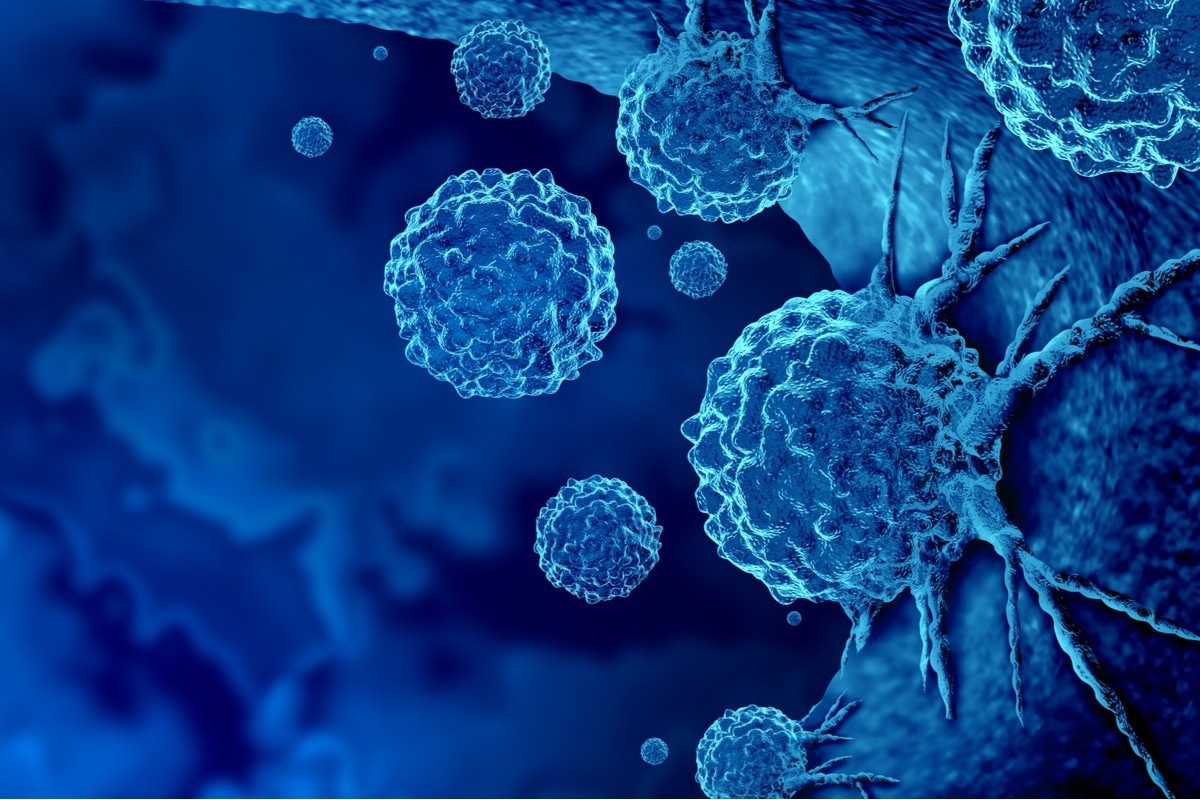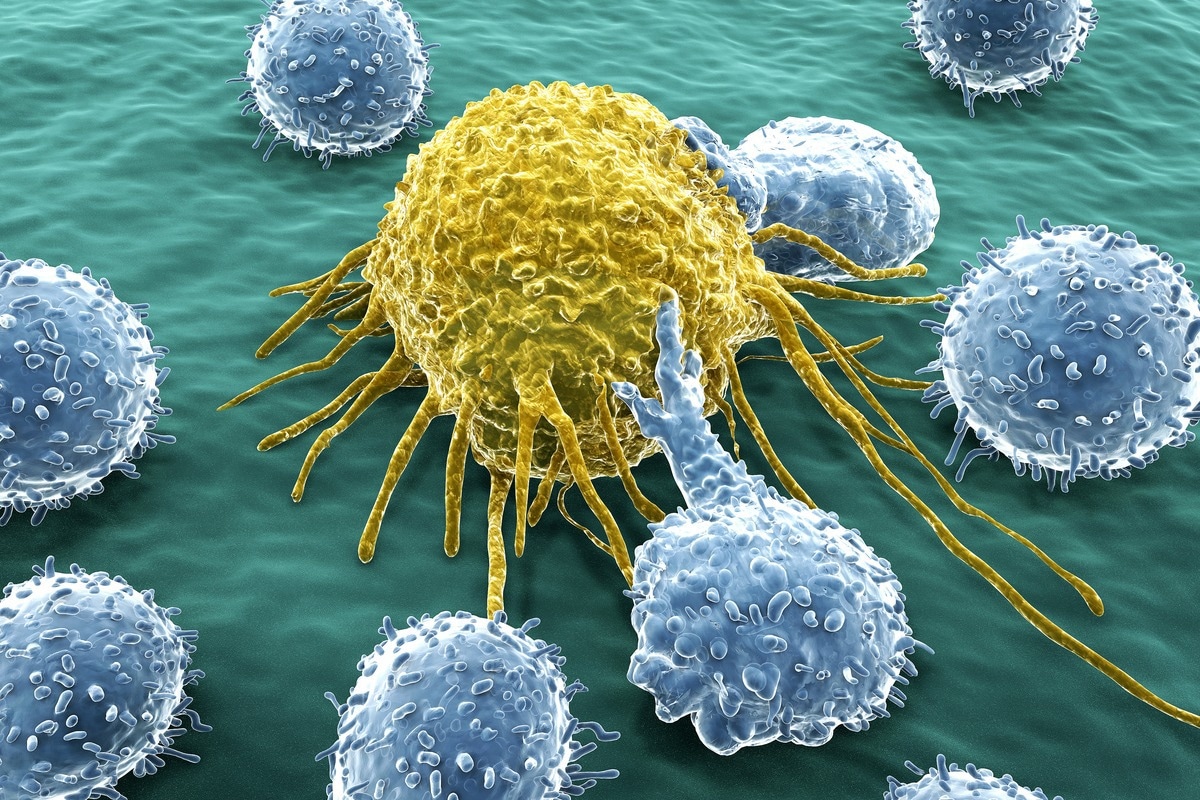Tumor antigens
Cancer immunoediting
Immunotherapy with neoantigen-based molecules
Prediction of neoantigens
Future directions
References
Further reading
Neoantigens are tumor-specific peptide antigens (TSAs) that arise due to mutations in tumor cells during their active replication. Other sources of neoantigens include viral infection, alternative gene splicing, and gene rearrangement.
Dying or dead tumor cells also release neoantigens that are taken up and cleaved within the immune cell. This is followed by the presentation of the resulting short peptides on the cell surface by the major histocompatibility complexes (MHC), called the human leukocyte antigen (HLA) in humans.

Image Credit: Lightspring/Shutterstock.com
They interact with specific T cell receptors (TCRs) to produce tumor-fighting T cell clones called tumor-infiltrating lymphocytes (TILs) that recognize these neoantigens as non-self antigens. These induce a potent immune response to the tumor.
Among all foreign elements in and on tumor cells, these are perhaps the most well-known. Neoantigens have become a crucial target of potential immunotherapy approaches to cancer treatment and diagnosis. Both immune checkpoint blockade agents and cancer vaccines are current targets of cancer immunotherapy.
Tumor antigens
Tumor antigens are classified as tumor-associated antigens (TAAs), cancer-germline/cancer-testis antigens (CTA), and tumor-specific antigens (TSAs). The last category comprises proteins expressed only in tumor cells, either from oncogenic viral genes expressing oncoproteins or peptides produced by somatic mutations.
Such mutations, arising from carcinogen exposure or due to the genomic instability of tumor cells, could lead to the production of abnormal protein sequences, or TSAs, by translation. They may include point mutations, frameshift mutations, nonstop mutations where the coding sequence is extended beyond the stop codon, insertions and deletions (indels), or chromosomal translocations.
Since all this follows the appearance of a neoantigen, the identification of neoantigens is of paramount significance in cancer immunotherapy.
Cancer mutations are not all TSAs, which, unlike TAAs, are unique to the individual. Most TSAs are private, with few being shared between tumors and individuals. Driver mutations are sometimes immunogenic, such as the chromosomal fusion mutations BCR-ABL or TEL-AML.
Cancer immunoediting
The interaction of the tumor cells with the immune system promotes tumor growth and induces an anti-tumor response. This has been called cancer immunoediting.
The immune response to neoantigens could destroy cancers in the preclinical stage, as well as make cancer cells more immunogenic so that they are recognized by cytotoxic T cells. Ultimately, these neoantigens are eliminated by appropriate manipulation of the immune response of the host, allowing the tumor to grow and spread.
Cancer immunoediting begins after cells transform into malignant cells, evading tumor suppression mechanisms. It comprises three phases.
The first is the elimination phase, where the innate and adaptive phases of the immune response recognize and clear tumor cells on the basis of tumor non-self antigens or neoantigens before they can establish themselves and grow or invade surrounding tissue. Neoantigens are thus prominent players in the immune rejection of tumors.

Image Credit: Juan Gaertner/Shutterstock.com
The second, or Equilibrium, phase occurs when the expansion of surviving tumor cells is limited by the immune response but without tumor suppression. The tumor progressively adapts itself to the immune milieu and may escape recognition by the immune system.
This ushers in the third phase of Immune Escape, where the tumor grows progressively, establishes its own immunosuppressive growth-friendly microenvironment and becomes clinically apparent. Immune escape is thus the hallmark of malignancy.
The immunosuppressive microenvironment of the tumor is established by tumor cells, immune cells, or both. Immune escape may occur via a number of mechanisms, including the removal of foreign antigens or the upregulation of proteins that allow the tumor cells to avoid apoptosis.
Suppressive cells may produce immunosuppressive cytokines or express immune checkpoints like the programmed death ligand 1 (PD-L1)/PD-1, cytotoxic T lymphocyte antigen-4 (CTLA-4), lymphocyte-activation gene 3 (LAG-3), T cell immunoglobulin and mucin domain 3 (TIM-3).
Immune checkpoints are negative regulators of the immune response and inhibit the anti-tumor response. Antibodies against these molecules release immune cells from inhibition and reactivate anti-tumor cellular immunity, leading to tumor cell destruction.
Immunotherapy with neoantigen-based molecules
The tumor neoantigens are key to cancer immunotherapy as they are unique to the tumor and can thus be differentially recognized and the cell thus destroyed selectively by the immune system. The specificity and reduced toxicity of this approach make it preferable to chemotherapy or radiation therapy.
The first molecule to be recognized as a target for T cell immunity was CTLA-4 and the first to be developed as a therapeutic target in cancer patients.
1. Immune checkpoint inhibitors
The immune checkpoint molecule CTLA-4 was first recognized as a potentially curative therapy that could reactivate and stimulate endogenous tumor-specific T cells to destroy cancer cells. The first FDA-approved immunotherapy molecule was ipilimumab, an anti-CTLA-4 monoclonal antibody. Others followed, such as the anti-PD-1 molecules nivolumab and pembrolizumab, and trials are ongoing to examine their utility in a broad range of cancers.
Historically, tumor mutational burden has been associated with greater clinical benefit in patients who receive immune checkpoint blockade therapy. This is not always true, however. A classic example is renal cell carcinoma (RCC), with a low mutation rate but a high response to immunotherapy.
The true functional targets of immune checkpoint inhibitors are TSAs, selected to prime and activate antigen-presenting cells and TCRs with a higher affinity toward MHC-neoantigen-peptide complexes and low vulnerability to central immune tolerance.
Anti-PD-1 therapy can lead to immunoediting, neoantigen depletion, and the clonal expansion of T cells. It promotes immune recognition of less immunogenic neoantigens remaining in the tumor, escaping immune detection. Or it may reverse T cell exhaustion so that neoantigens are recognized and the target cells destroyed.
2. Cancer vaccines
Cancer vaccines are another field of research where numerous studies and trials have been conducted. The first vaccines, and the majority so far, have been based on shared cancer neoantigens and have successfully generated immune responses. However, the clinical response has been discouraging in terms of reduced tumor volume or tumor regression, except for the rare and unpredictable success.
Later research showed that the reason for this could have been the low number of tumor-specific T cells induced by the vaccine, due to inadequate antigen delivery, and also the presence of immune checkpoints that prevented T cell reactivation. This could be related to the use of tumor-associated self-antigens to which immune tolerance had already been achieved by immunoediting.
Newer therapeutic vaccines are being tested at present that target TSAs. These are coupled with anti-PD1 or anti-CTLA4 immune checkpoint blockers for greater efficacy.
Neoantigen vaccines not only expand TIL clones but can reactivate previously undetectable neoantigens lost to immunoediting. This is because the tumor-reactive T cells recognize and destroy multiple tumor cell clones.
3. Adoptive T cell transfer
Neoantigens can be used to expand specific T cells that are reactive to the tumor cells. This is one component of adoptive cellular therapy (ACT), where TILs are resected, cultured, and transfused in bulk into the patient to destroy the tumor. By removing tumor-specific T cells from the immunosuppressive tumor microenvironment, they are restored to cytotoxic anti-tumor T cell status before being transferred back into the patient.
This attempt to shift back to the elimination phase can be made much more potent if T cells that recognize TSAs or neoantigens are isolated instead for bulk infusion. The outcome of adoptive T cell transfer includes expansion of tumor-reactive T cells, anti-tumor activity, and long-term maintenance of the response via memory T cells.
Recent advances in synthetic biology have led to the development of high-affinity T cells with engineered TCRs or chimeric antigen receptors (CARs). This approach offers the ability to overcome immune tolerance to the tumor and activate a potent immune response to the cancer cells in an immunocompromised patient. Such therapeutic drugs can also prevent off-target destruction of healthy tissue by not targeting self-antigens.
Prediction of neoantigens
Shared neoantigens are uncommon, and the benefit of therapies targeting them may be relatively low because of this, as well as of HLA restriction of the neoantigens. Instead, TSAs are now being predicted, using antigen processing tools to identify canonical and emerging tumor epitopes. This will include epitopes that have undergone post-translational modification or spliced peptides.
The prediction of neoantigens has been made possible currently by the use of sophisticated technology, such as next-generation sequencing, and computational advances such as machine learning with the help of algorithms. Neoantigens of therapeutic importance activate major histocompatibility complex (MHC) class I (MHC I) and MHC class II (MHC II) epitopes, making it clear that both are essential for anti-tumor immunity to be effective.
Future directions
Current technology should help screen the small number of truly relevant neoantigens from a large number of candidate neoantigens. This identification rests on selecting TSAs that are non-self antigens unique to the tumor cells and immunogenic antigens that can stimulate large numbers of unique anti-tumor CD4 and CD8 T cells. Coupled with the use of effective immune checkpoint inhibitors, these can activate potent and abundant tumor-selective T cells and inhibit the tumor’s immunosuppressive milieu for a sustained T cell response over the long term.
Apart from these, a combination of neoantigen-based therapies with conventional cancer therapies like chemoradiotherapies, kinase inhibitors, or anti-angiogenesis therapies may improve the reach and potency of tumor destructive T cells.
This knowledge, combined with the ability to predict neoantigens, selection of functional targets, the understanding of their role as the targets of immune checkpoint inhibitors, and the growing number of approaches to counter the immunosuppressive tumor microenvironment, means that the field of cancer vaccines is at a critical phase of development. As some researchers think, “There now exists the potential to develop therapeutic cancer vaccine regimens that specifically and potently target tumors in the majority of patients with advanced stage disease.”
References
- Lee, C.-H. et al. (2021). Update on Tumor Neoantigens and Their Utility: Why It’s Good to Be Different. Trends in Immunology. https://dx.doi.org/10.1016%2Fj.it.2018.04.005. https://www.ncbi.nlm.nih.gov/pmc/articles/PMC7954132/. Accessed on May 19, 2022.
- Efremova, M. et al. (2017). Neoantigens Generated by Individual Mutations and Their Role in Cancer Immunity and Immunotherapy. Frontiers in Immunology. https://doi.org/10.3389/fimmu.2017.01679. https://www.frontiersin.org/articles/10.3389/fimmu.2017.01679/full. Accessed on May 19, 2022.
- Kalos, M. et al. (2013). Adoptive T cell Transfer for Cancer Immunotherapy in the Era of Synthetic Biology. Immunity. https://dx.doi.org/10.1016/j.immuni.2013.07.002. https://www.ncbi.nlm.nih.gov/pmc/articles/PMC3809038. Accessed on May 19, 2022.
- T-cell Transfer Therapy (2022). https://www.cancer.gov/about-cancer/treatment/types/immunotherapy/t-cell-transfer-therapy. Accessed on May 19, 2022.
- Ward, J. P. et al. (2016). The Role of Neoantigens in Naturally Occurring and Therapeutically Induced Immune Responses to Cancer. Advances in Immunology. https://dx.doi.org/10.1016/bs.ai.2016.01.001. https://www.ncbi.nlm.nih.gov/pmc/articles/PMC6087548/. Accessed on May 19, 2022.
- Peng, M. et al. (2019). Neoantigen Vaccine: An Emerging Tumor Immunotherapy. Molecular Cancer. DOI: https://doi.org/10.1186/s12943-019-1055-6. https://molecular-cancer.biomedcentral.com/articles/10.1186/s12943-019-1055-6. Accessed on May 19, 2022.
- Zhu, Y. et al. (2021). The Role of Neoantigens in Cancer Immunotherapy. Frontiers in Oncology. https://dx.doi.org/10.3389%2Ffonc.2021.682325. https://www.ncbi.nlm.nih.gov/pmc/articles/PMC8429900/. Accessed on May 19, 2022.
Further Reading
Last Updated: Jun 21, 2022